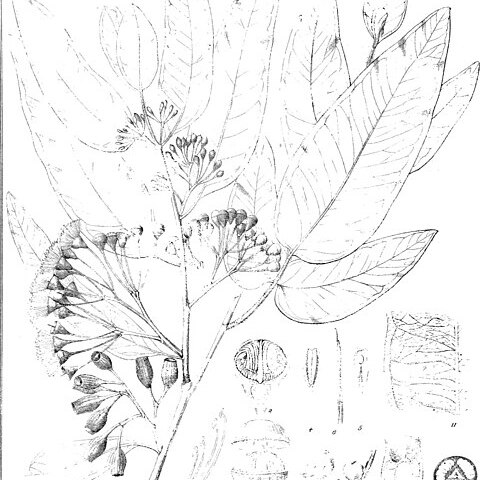Tree to 5(15) m tall. Probably forming a lignotuber.Bark smooth pale grey and white over all or most of trunk, sometimes partly rough, thin and irregularly flaky-tessellated on lower trunk.Branchlets lack oil glands in the pith; smooth (not scabrid).Juvenile growth (coppice or field seedlings to 50 cm): not seen. Crown predominantly of alternate adult leaves, with few pairs opposite.Adult leaves alternate, petioles 1–2.2 cm long; blade lanceolate or elliptical, 7–16 cm long, 1.4–2.5 cm wide, flat or slightly undulate, base tapering to petiole, margin entire or irregularly indented, apex pointed, concolorous, dull (fide Hill & Johnson 1995, p. 413), green, side-veins at less than or greater than 45° to midrib, reticulation dense to ?very dense, intramarginal vein present, oil glands obscure.Inflorescence axillary compound, with rhachis having a basal internode about 0.6 cm long and sometimes a second shorter internode, peduncles variable within an inflorescence, 0–1.4 cm long, buds 3 or 7 per umbel, pedicels 0.8–1.7 cm long. Mature buds obovoid to pyriform (ca 0.7 cm long, 0.4 cm wide), smooth, scar present (outer operculum shed early), operculum shallowly rounded, stamens inflexed, all fertile, anthers oblong, dorsifixed, versatile, dehiscing by longitudinal slits, style long and straight, stigma ± blunt, locules 3, ovules not arranged in distinct vertical rows on the placentae. Flowers white.Fruit pedicellate (pedicels 0.9–1.7 cm long), urceolate to barrel-shaped, 0.7–0.9 cm wide, 0.9–1.4 cm long, thin-walled, disc descending, valves 3, enclosed.Seeds not seen. Cultivated seedlings (measured at ca node 10): not grown.
More
Tree to 10 m. Bark tessellated, grey to 3 m, smooth and grey to grey-white above. Juvenile leaves petiolate, ovate, setulose on petiole and veins of the undersurface. Adult leaves mostly alternate, sometimes opposite, petiolate, lanceolate or broadly lanceolate, acute, usually rounded, thick; lamina 11–19 cm long, 2–4 cm wide, grey-green, concolorous; lateral veins prominent, at 40°–60°; intramarginal vein up to 1 mm from margin; petiole 1–2 cm long. Conflorescence axillary, compound; umbels up to 11-flowered, sessile or on peduncle up to 3.5 cm long; pedicels 1.2–2.2 cm long. Buds clavate; operculum c. 2 mm long, 5–6 mm wide; hypanthium obconical, 5–6 mm long and wide. Fruits truncate-ovoid, venulose, 9–10 mm long, 8–9 mm wide. Seeds not winged but with a rudimentary margin.


